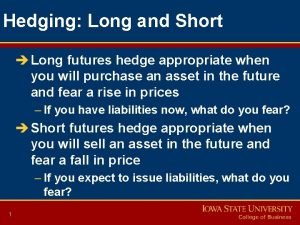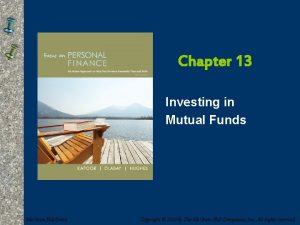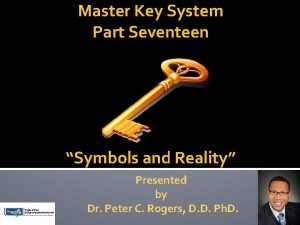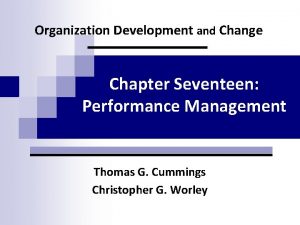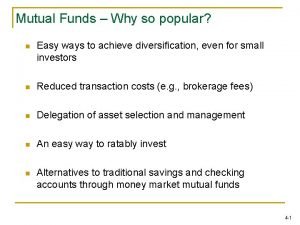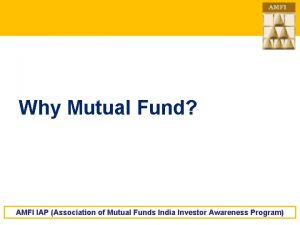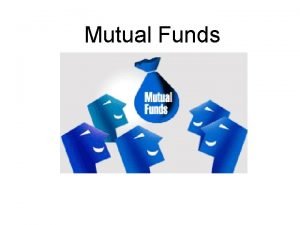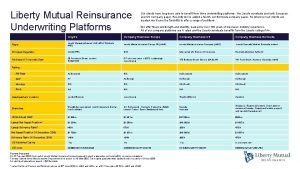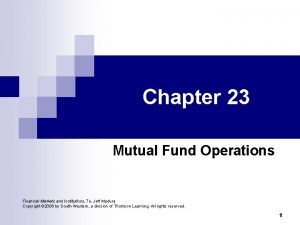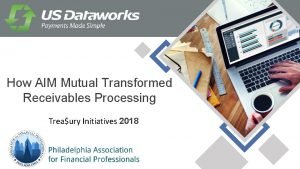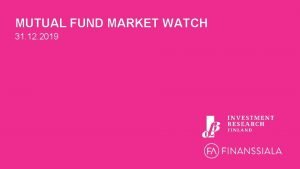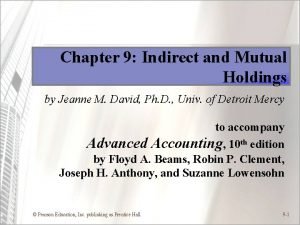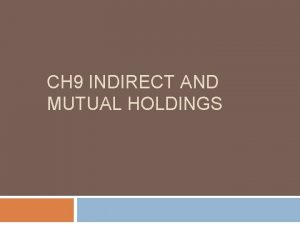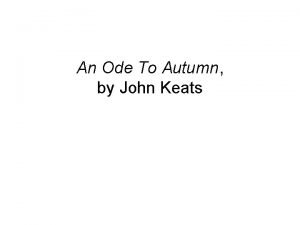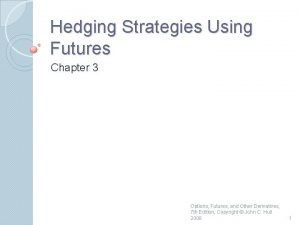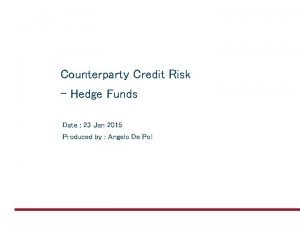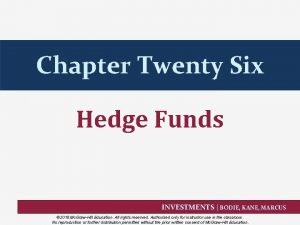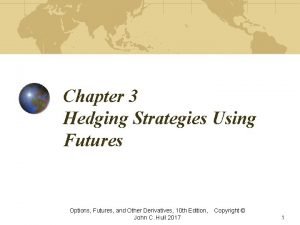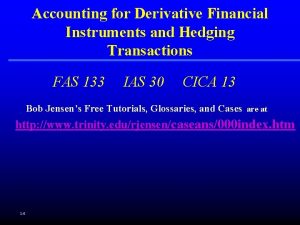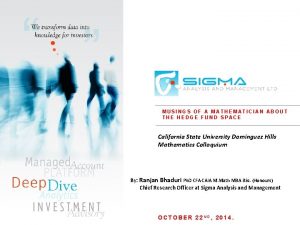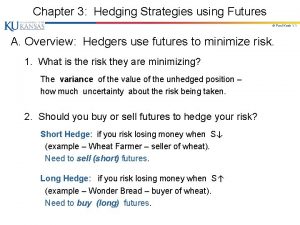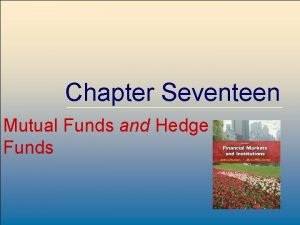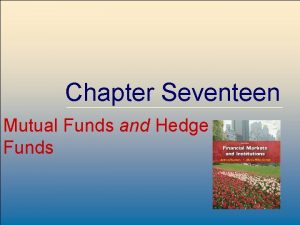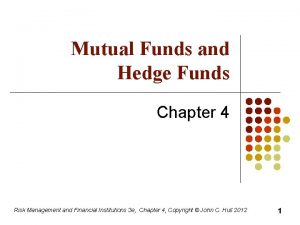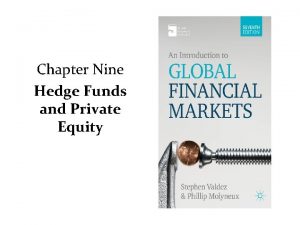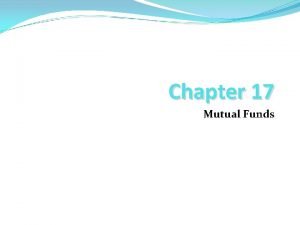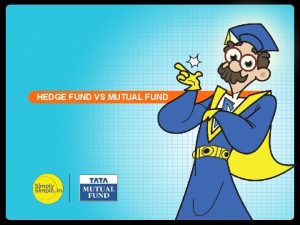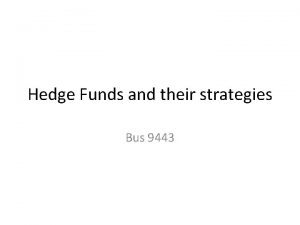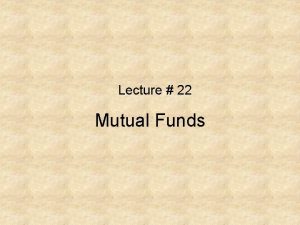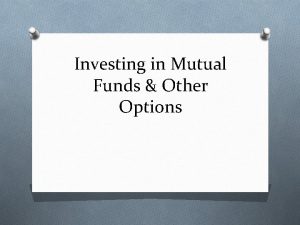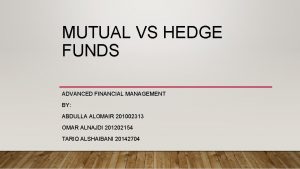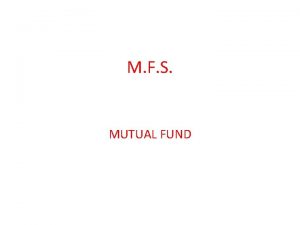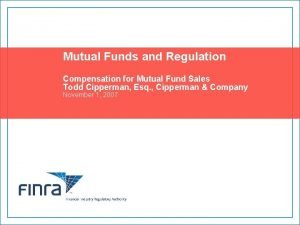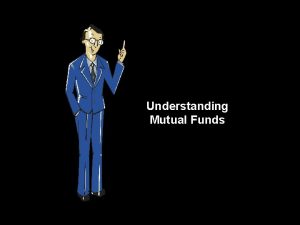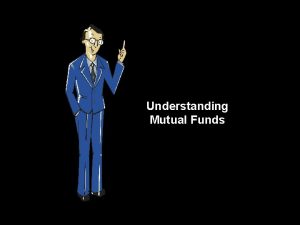Chapter Seventeen Mutual Funds and Hedge Funds Mc






























- Slides: 30

Chapter Seventeen Mutual Funds and Hedge Funds Mc. Graw-Hill/Irwin Copyright © 2012 by The Mc. Graw-Hill Companies, Inc. All rights reserved.

Mutual Funds and Hedge Funds l l l Mutual Funds (MFs) and Hedge Funds (HFs) are financial institutions (FIs) that pool the financial resources of individuals and companies and invest those resources in portfolios of assets The first MF was established in Boston in 1924 By 1970, 360 MFs held about $50 billion in assets Money market mutual funds (MMMFs) were introduced in 1970 Tax-exempt MMMFs were introduced in 1979 By 2010, more than 7, 567 MFs held just over $11 trillion in assets 17 -2

Mutual Funds l l Cash flows into MFs are highly correlated with the return on stock markets Growth has also resulted from the rise in retirement funds under management by MFs l l MFs managed ~ 25% of retirement fund assets in 2010 MFs are the second most important group of FIs as measured by asset size; second only to commercial banks Banks’ share of all MF assets was 8% in 2010 Insurance companies managed 7% of MF industry assets in 2010 17 -3

Money Market Mutual Funds Money Flows 17 -4

Primary Reserve Money Fund l l l In September 2008, Primary Reserve Fund--a money market mutual fund--‘broke the buck’ and had its share value fall below the standard $1 due to losses on $785 million of commercial paper issued by Lehman brothers This led to contagion and a run on money funds with over $200 billion outflows over the next few days The Treasury guaranteed payments on money funds for one year to stop the runs. The insurance ran out September 19, 2009. 17 -5

Mutual Funds l The barriers to entry in the MF industry are low l l the largest MF sponsors have not increased their market share recently l the largest 25 MF companies managed 76% of industry assets in 1990 l the largest 25 MF companies managed 75% of industry assets in 2010, about the same the composition of the top 25 firms in the industry has changed l seven of the largest 25 firms in 2010 were not among the top 25 in 1990 17 -6

Mutual Funds l The MF industry has two sectors l short-term funds invest in securities with original maturities of less than one year money market mutual funds l tax-exempt money market mutual funds long-term funds invest in portfolios of securities with original maturities of more than one year l equity funds consist of common and preferred stock l bond funds consist of fixed-income capital market debt securities l hybrid funds consist of both stock and bond securities l l 17 -7

Mutual Funds l Approximately 25% of long-term funds are index funds l l l index funds are funds in which managers buy securities in proportions similar to those included in a specified major index funds involve little research or management, which results in lower management fees and higher returns than actively managed funds Exchange traded funds (ETFs) are also designed to replicate market indexes l l l traded on exchanges at prices determined by the market management fees are lower than actively traded funds unlike index funds, ETFs can be traded during the day, sold short, and purchased on margin 17 -8

Mutual Funds l l Money market mutual funds (MMMFs) provide an alternative investment to interest-bearing deposits at commercial banks l bank deposits are relatively less risky, because they are FDIC insured, and generally offer lower returns than MMMFs Households own the majority of MFs l owned 59. 8% of long-term funds in 2010 l owned 40. 2% of short-term funds in 2010 l 43. 9% of all U. S. households owned MFs in 2010—which represents ~51. 6 million households 17 -9

Mutual Funds l MF managers must specify their fund’s investment objectives in a prospectus (a formal summary of a proposed investment), which is made available to potential investors l holds lists of the securities invested in by the funds l in 1998 the Securities and Exchange Commission (SEC) mandated that prospectuses must be written in “plain English” instead of overly legal language (i. e. , legalese) 17 -10

Mutual Funds l l l Mutual funds are required to publish the specific objectives of the fund in the prospectus No investor should invest in a fund without carefully reading the prospectus The prospectus will contain historical return information, usually for 1 -year, 3 -year and 5 -year periods and perhaps longer The prospectus must also show historical fees and the effect of those fees on a given investment over time Little information on risk is usually provided 17 -11

Types of Mutual Funds 17 -12

Largest Mutual Funds in Assets Held (2010) 17 -13

Mutual Funds l Investor returns from MF ownership reflect three components l l MF assets are marked to market daily l l income and dividends on portfolio assets capital gains on assets bought and sold at higher prices capital appreciation on assets held in the fund prices are adjusted daily to reflect changes in the current market prices of the portfolio’s assets Then net asset value (NAV) of a MF share is equal to the market value of the assets in the MF portfolio less liabilities divided by the number of shares outstanding 17 -14

Mutual Funds l l l An open-end MF is a fund for which the supply of shares is not fixed, but can increase or decrease daily with purchases and redemptions of shares A closed-end investment company is a specialized investment company that has a fixed supply of outstanding shares, but invests in the securities and assets of other firms A real estate investment trust is a closed-end investment company that specializes in investing in mortgages, property, or real estate company shares 17 -15

Mutual Funds l MFs charge investors fees for the services they provide l l l sales loads 12 b-1 fees are fees related to the distribution costs of MF shares l cannot exceed 1% of average annual net assets for load funds l cannot exceed 0. 25% of average annual net assets for noload funds MFs may offer different share classes with different combinations of loads A load fund is an MF with an up-front sales or commission charge that the investor must pay A no-load fund is an MF that does not charge up-front sales or commission charges on the sale of mutual fund shares to investors 17 -16

Mutual Funds l In 2010 average fees and expenses paid by mutual fund investors were 0. 99% on stock funds and 0. 75% on bond funds l These expenses have continued to fall over the last decade 17 -17

The Effect of Costs on MF Returns This year an investor placed $10, 000 in a mutual fund with a 6% load (one time fee) and estimated annual expenses of 1. 35%. Fees are charged against average assets for the year. The fund’s gross return is 11. 5%. What was the investor’s first year return net of loads and expenses? = $10, 000 – (0. 06 $10, 000) = $9, 400 Amount initially invested = $9, 400 1. 115 = $10, 481 Amount after gross return Average asset value for year = ($10, 481 + $9, 400) / 2 = $9, 940. 50 * 0. 0135 = $134. 20 Fees = $10, 481 - $134. 20 = $10, 346. 80 Ending amount after fees Net rate of return (first year) = ($10, 346. 80 / $10, 000) – 1 = 3. 47% 17 -18

Mutual Funds l MFs are heavily regulated because they manage and invest small investor savings l The SEC is the primary regulator The Securities Act of 1933 l The Securities Exchange Act of 1934 The Investment Advisers Act and Investment Company Act of 1940 The Insider Trading and Securities Fraud Enforcement Act of 1988 The Market Reform Act of 1990 The National Securities Market Improvement Act (NSMIA) of 1996 l l l 17 -19

Mutual Funds l Even with heavy regulation, investor abuses still occur l l market timing is short-term trading that profits from out-of -date values on the securities in the fund’s portfolio late trading involves buys and sells long after prices have been set at 4: 00 pm E. T. directed brokerage occurs when brokers improperly influence investors on their fund recommendations improperly assessed fees occur when brokers trick customers into thinking they are buying no-load funds or fail to provide discounts properly 17 -20

Global Issues l l During the 1990 s mutual funds were the fasting growing financial institution in the United States Growth slowed or declined in most major countries of the world in 2001, reversing a decade long trend, but picked up again as the economic growth improved in the mid-2000 s, only to decline again during the crisis In the late 2000 s growth in non-U. S. investments outpaced growth in U. S. funds Total assets of non-U. S. mutual funds were $162. 6 billion in 1992 and, as of 2010, there were $14. 13 trillion invested in mutual funds outside the U. S. 17 -21

Hedge Funds l Hedge funds (HFs) are investment pools that solicit funds from wealthy individuals and other investors (e. g. , commercial banks) and invest these funds on their behalf l l similar to MFs, but smaller funds are not required to register with the SEC subject to less regulatory oversight than mutual funds and generally can (and do) take significantly more risk than MFs do not have to publicly disclose their activities to third parties and thus offer a high degree of privacy HFs avoid regulation by limiting the number of investors to less than 100 and by requiring investors to be “accredited” l accredited investors have net worth over $1 million or annual income over $200, 000 if single (or $300, 000 if married) 17 -22

Hedge Funds l HFs use more aggressive trading strategies than MFs such as short selling, leverage, program trading, arbitrage, and the use of derivatives l Because not all HFs are registered, industry and firm data cannot be accurately tracked ~ 10, 000 HFs in the U. S. in 2010 ~ $1. 77 trillion in assets in 2010 ~ new asset flows track market performance 17 -23

Hedge Funds l There are three basic types of HFs l l l the most risky - HFs use market directional trading strategies, seek high returns using leverage, and invest based on anticipating events moderate risk - HFs have a market neutral (or value) orientation that favors longer-term investment strategies risk avoidance - HFs take a market neutral approach and strive for consistent returns with low risk 17 -24

Hedge Funds l l Management fees on HFs are computed as a percent of assets under management and run between 1. 5% and 2% Performance fees give fund managers a share of any positive returns earned l l the average is 20%, but performance fees vary substantially depending on the HF a hurdle rate is a benchmark that must be realized before a performance fee can be assessed a high-water mark is when a manager does not receive a performance fee unless the value of the fund exceeds the highest NAV it has previously achieved Offshore HFs are attractive to investors because they provide anonymity and are not subject to U. S. taxes 17 -25

Hedge Funds 17 -26

Hedge Funds l HFs under $100 million in assets are exempt from registration requirements set forth by the Investment Company Act of 1940 l l l HFs have less than 100 investors each, accredited investors, and are sold only as private placements HFs are prohibited from abusive (i. e. , illegal) trading practices The Dodd-Frank bill requires that hedge funds with more than $100 million register with the SEC under the Investment Advisors Act 17 -27

Hedge Funds l Fund advisors must now report financial information on the funds they manage to the FSOC to help limit systemic risk in the economy l The Federal Reserve can also exercise oversight of funds deemed large enough or interconnected enough to present a systemic risk 17 -28

Hedge Funds Performance l l The financial crisis reduced the amount of assets in hedge funds because of losses, although a few funds did well during the crisis The typical hedge fund had negative returns of 15. 7% in 2008, with about 75% of funds losing money that year Even so, many funds outperformed the indexes in the same time period. Although returns were far better in 2009 (in the 20% range), the funds underperformed the S&P 500 over that time period Fund redemptions followed a similar pattern during the crisis as mutual funds flows 17 -29

High Profile Hedge Funds Problems l l l The collapse of the two Bear Stearns hedge funds led to investor losses of $1. 6 billion and led to the bankruptcy of the company Bernard Madoff Investment Securities run by former NASDAQ chairman Bernie Madoff ran a $65 billion Ponzi scheme In October 2009 a large hedge fund, Galleon Group LLC, was closed due to an insider trading scandal 17 -30
 Hedge ratio
Hedge ratio Forward exposure
Forward exposure Chapter 13 investing in mutual funds
Chapter 13 investing in mutual funds Dance moms seventeen magazine
Dance moms seventeen magazine Seventeen master key
Seventeen master key Parfoy
Parfoy Seventeen table
Seventeen table Mutual funds examples
Mutual funds examples Iap mutual funds
Iap mutual funds Mutual funds disclaimer
Mutual funds disclaimer Mutual fund disclaimer
Mutual fund disclaimer Meritas mutual funds
Meritas mutual funds Reinsurance mutual funds
Reinsurance mutual funds Mutual funds operations
Mutual funds operations Aim mutual funds
Aim mutual funds Mutual funds market watch
Mutual funds market watch Indirect and mutual holdings chapter 9
Indirect and mutual holdings chapter 9 Indirect and mutual holdings
Indirect and mutual holdings Hilly bourn
Hilly bourn Mad hedge fund trader
Mad hedge fund trader Chapter 3 hedging strategies using futures
Chapter 3 hedging strategies using futures Hedge fund credit risk
Hedge fund credit risk Hedge fund high water mark
Hedge fund high water mark Hedging strategies using futures
Hedging strategies using futures Hedge ratio formula
Hedge ratio formula Optimal hedge ratio
Optimal hedge ratio Hedge statement
Hedge statement Derivative instrument
Derivative instrument John thomas mad hedge fund
John thomas mad hedge fund Mathematician hedge fund
Mathematician hedge fund Tailing the hedge
Tailing the hedge
